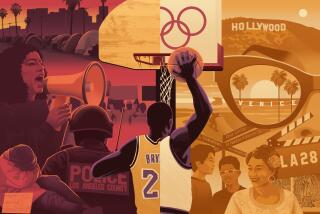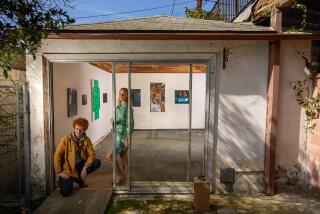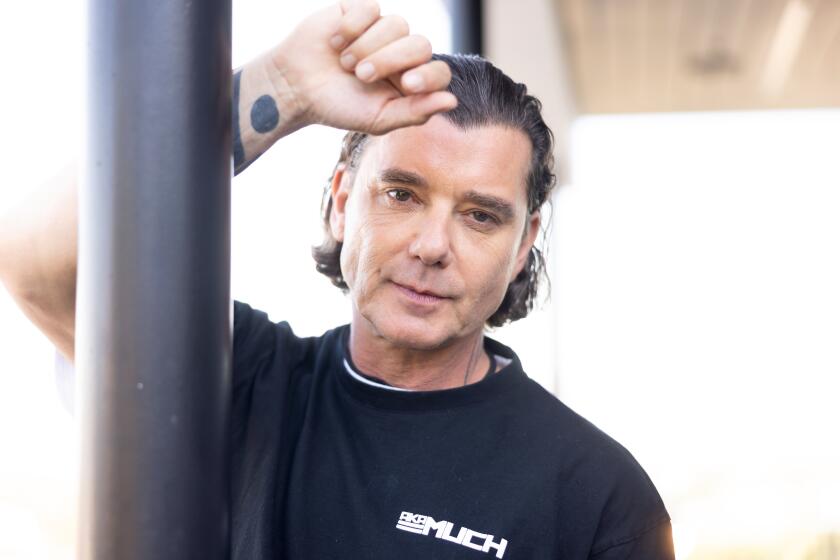‘Life in a Day of Black L.A.’ : New California Afro-American Museum Exhibit Offers Angelenos a Rare ‘Mirror’
- Share via
Though commonplace in the city’s urban landscape, the images resonate with warmth and familiarity: a smiling cop, a woman carefully arranging her daughter’s hair before the girl goes off to school, a young family out walking the dog.
Other images paint the city’s darker half. Street scenes pockmarked by graffiti, a man standing on a trash-littered sidewalk below a slashed billboard that reads “Commitment to Excellence,” the smoldering remains of a fire-ravaged building.
All of these images and more will be displayed starting Thursday at the California Afro-American Museum in an exhibit titled “Life in a Day of Black L.A.: The Way We See It.” The show is a collection of 100 photos by 10 black photographers who have documented nuances of black life too rarely seen, said exhibit co-curator Roland Charles.
“We’ve been investigated by everybody but us,” said Charles, a photojournalist whose work is part of the exhibit. “The ordinary things depicted in the show are extraordinary because they aren’t represented. Here, blacks are representing their own culture.”
The photos, culled from 150 published last December in a book with the same title, document the events that constitute a typical day: hauling golf clubs to the course for an early morning tee time, waiting for a bus, getting a haircut, closing a business deal.
Among the faces are those of such well-known figures as Bishop Carl Bean, Rep. Maxine Waters (D-Los Angeles), actor Billy Dee Williams and sprinter Evelyn Ashford. Yet rather than stand out, the famous faces simply meld into the flow of everyday life that the photos represent. It is the sum of all parts of life that make up the richly textured whole that Charles said he and other artists sought to capture.
“People really want to know what goes on in the black community, particularly after the unrest last year,” said Toyomi Igus, exhibit co-curator and co-editor of the book. “And not just whites, but blacks, too. There’s a sense of recognition among black folks when they see these pictures, like, ‘Oh yes, I know that person,’ or ‘I do that.’ It’s a mirror of ourselves that we don’t get to look in very often.”
Igus, who is managing editor of the publications unit for UCLA’s Center for Afro-American Studies, said she agreed to collaborate with Charles on the book and exhibit when he approached her with the idea two years ago. Charles said the idea was a natural outgrowth of his work at the Black Gallery, a fine art photography gallery he has operated in the Crenshaw district since 1984.
For the project, Charles enlisted the help of fellow photographers Nathaniel Bellamy, Don Cropper, Calvin Hicks, James Jeffrey, Mike Jones, Rod Lyons, Karen Kennedy, Willie Meadowbrook and Akili-Casundria Ramsess. Their black-and-white photos brought together diverse walks of life, from a shot of a Baldwin Hills couple posing with his-and-hers Mercedes to a homeless man seeking work at an Inglewood job fair.
But last April, as the book’s pages were being laid out and readied, the riots swept through Los Angeles. Suddenly, there was a segment of black life that Charles and others knew could not be left out of the collection.
“I spoke to Roland about it, and we both decided to shoot right away and edit later,” recalled Jeffrey, whose photo of a group of young people wandering amid post-riot ruins at Florence and Normandie avenues, the image framed in a broken shell of a television set, provides the book’s compelling cover photo. In the end, 50 riot-related photos were appended to the book.
“Even during the riots, we got pictures that were pathetic, ironic, even funny,” Jeffrey said, citing one by Charles of a black policewoman and National Guardsman protecting an Asian-owned establishment. “This show is a great opportunity to give people more than the 30-second TV bite of black people they’re used to.”
For Ramsess, shooting photos for the exhibit (150 were selected out of the 10,000 submitted) was a labor of love.
“It came from the heart,” said Ramsess, whose contributions include Venice beach body boarders riding the waves and a plaid-suited teacher presiding over his class at the Marcus Garvey school in South Los Angeles.
“We’re all so inundated with negative images, we don’t take deeper looks. There are broader elements of our community. . . . We’re aren’t all gangbangers, welfare mothers and whatever other stereotypes people put on us.”
A “community day” will be held Saturday from 1 to 3 p.m. at the museum, 600 State Drive in Exposition Park. The public is invited to meet the artists and hear them discuss their photographs. The exhibit runs through Sept. 5.
More to Read
The biggest entertainment stories
Get our big stories about Hollywood, film, television, music, arts, culture and more right in your inbox as soon as they publish.
You may occasionally receive promotional content from the Los Angeles Times.










